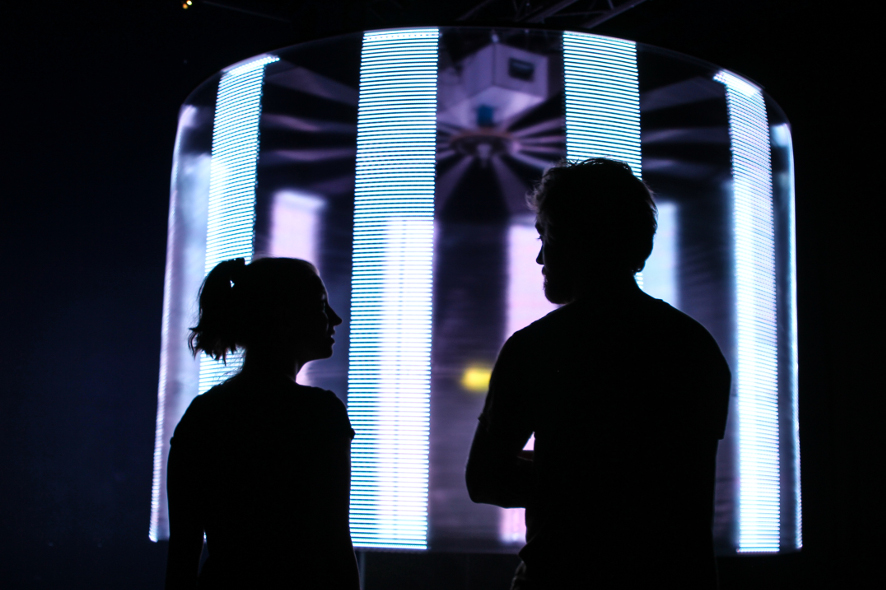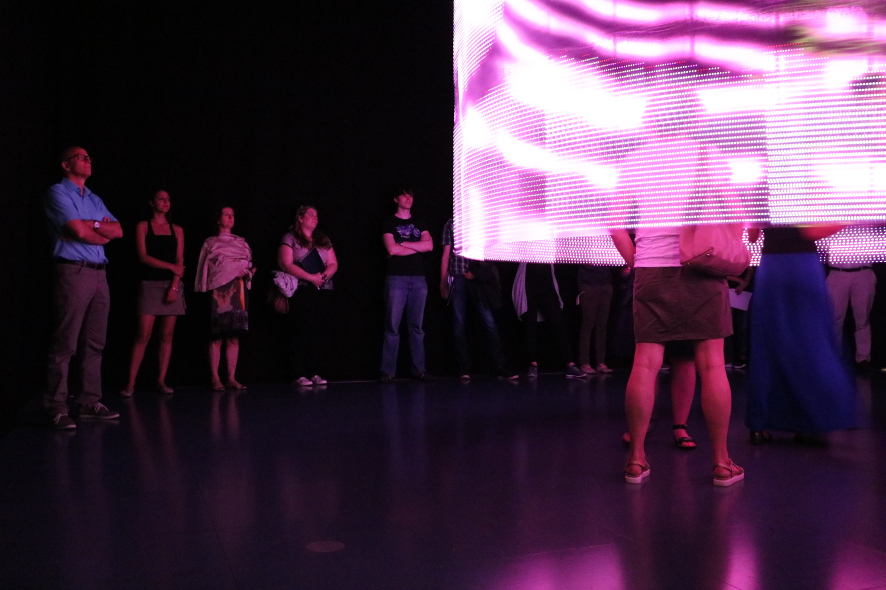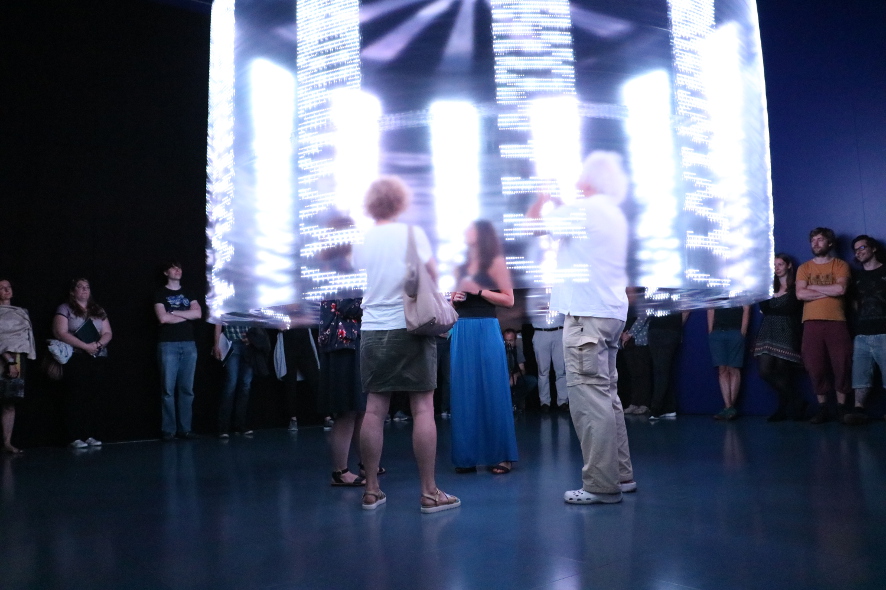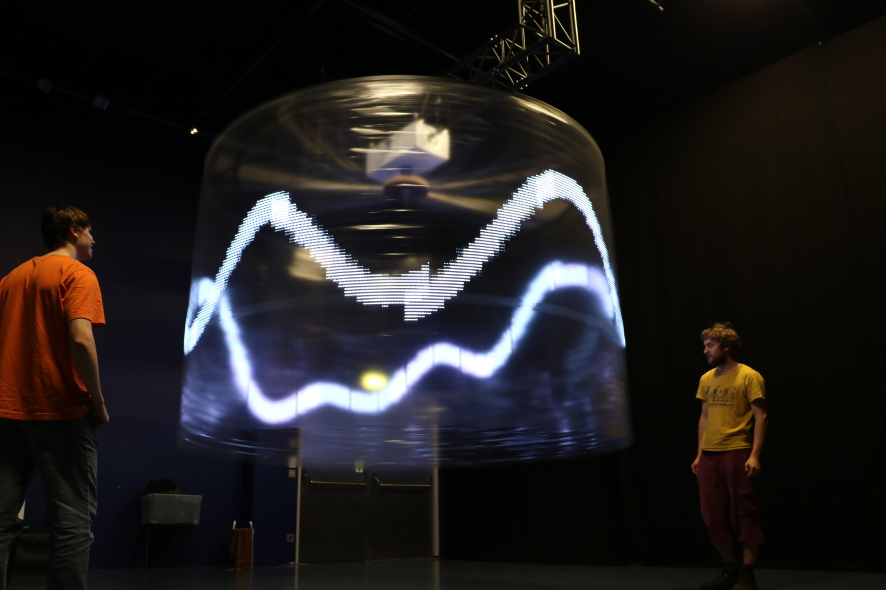TIME OUT .06 is a collaborative effort between the University of Arts and Industrial Design Linz and the Ars Electronica Center. Once again, students of the bachelor degree course Time-based and Interactive Media get the opportunity to display their works of media art. Lightstorm by Katharina Gruber, Laurin Döpfner and Gregor Woschitz is one of the works featured in the exhibition.
The installation is two meters high, has a diameter of three meters and rotates at a speed of almost 35 kph. It consists of a huge rotating tube with LED strips embedded all around its inner and outer surface. When the cylinder is in motion, the viewer’s visual system interprets the flashing LEDs as a drawing in mid-air. Impressions of pulsating images in space occur on the retina.
We spoke to the three students involved in the project to find out what Lightstorm is all about.

Credit: Martin Hieslmair
Lightstorm is meant to symbolize the individual amidst the maelstrom of city life. How did you come up with the idea for this project?
Katharina Gruber: We saw a huge abstract painting by a young artist that was on display at an art gallery in Vienna. Despite the chaos in this painting, it also created a sense of calmness—just like being in the eye of a tornado. You get a similar feeling when you try to consciously perceive the frenetic pace of big-city life, instead of just going with the flow. As we were thinking about this topic, images of rapidly passing lights that change the perception and validity of what is seen came to mind.

Credit: Magdalena Leitner
Why do you care about this topic?
Gregor Woschitz: This is an issue that concerns everyone! Light pollution in the cities, caused by advertising signs, media facades and other artificial lighting, has been increasing at a dramatic rate. The acceleration of daily life as a result of digital media and other technological developments is a challenge for all of us. In today’s fast-paced world it is becoming increasingly difficult to find serenity. We are constantly under pressure to keep up with our busy lifestyles and often end up feeling rushed and overwhelmed. The new method of transmitting information uses light instead of electricity. Although light is intangible, we are all surrounded by it.

Credit: Magdalena Leitner
When the cylinder is in motion, our eyes perceive images. How exactly does this work?
Laurin Döpfner: If images or colors are displayed in rapid succession, the brain blends them into a single, continuous motion. This phenomenon is known as the persistence of vision. A well-known experiment that demonstrates this effect is the thaumatrope. A disk or rectangle with a bird on one side, and a cage on the other is attached to a string. When spun, the bird appears to be in its cage. If you apply the same principle to flashing, moving objects, you can make drawings in mid-air.

Credit: Martin Hieslmair
To what extent did you benefit from the Time-based and Interactive Media program at the University of Arts and Industrial Design Linz?
Gregor Woschitz: Quite a lot—we learned the fundamental technical principles there. However, while the study program is very broad in its scope, the project has much more depth. Therefore, we needed a lot of expertise that we either already had or had to acquire. It is important to mention that without the support of the University, which provided rooms and infrastructure, and the dedicated professors this project would not have been possible.

Credit: Magdalena Leitner
Who is responsible for what in this project? You work on this project as a team of three. Does this make work easier or do you sometimes have different opinions?
Katharina Gruber: Actually, we disagree on many things. But this is exactly what adds that extra something to this project. Differing opinions lead to more diverse ideas. Many of the ideas have already been implemented, while others must wait a little longer. Of course, we distributed tasks among the team members according to areas of expertise. However, especially in the beginning, each of us was responsible for everything, which was due to the fact that we had entered completely new territory.

Credit: Magdalena Leitner
What were the biggest challenges during this project?
Laurin Döpfner: We had to step way out of our comfort zone. One major challenge was the mechanism of this work of kinetic art. The physical forces occurring during operation are not to be underestimated. Apart from that, we had to optimize the data transfer in order to be able to drive the LEDs at full capacity and thus achieve the best possible frame rate and resolution. At the same time, we wanted to be able to play the surface of the object in real-time as we are planning to present the installation in a performance context in the future.
You can find the “Lightstorm“ at the Ars Electronica Center in the Main Gallery at the floor -3.
Presentation Times:
SAT, SUN, holidays: 11 AM-5 PM (every full hour)
TUES-FRI: on demand
